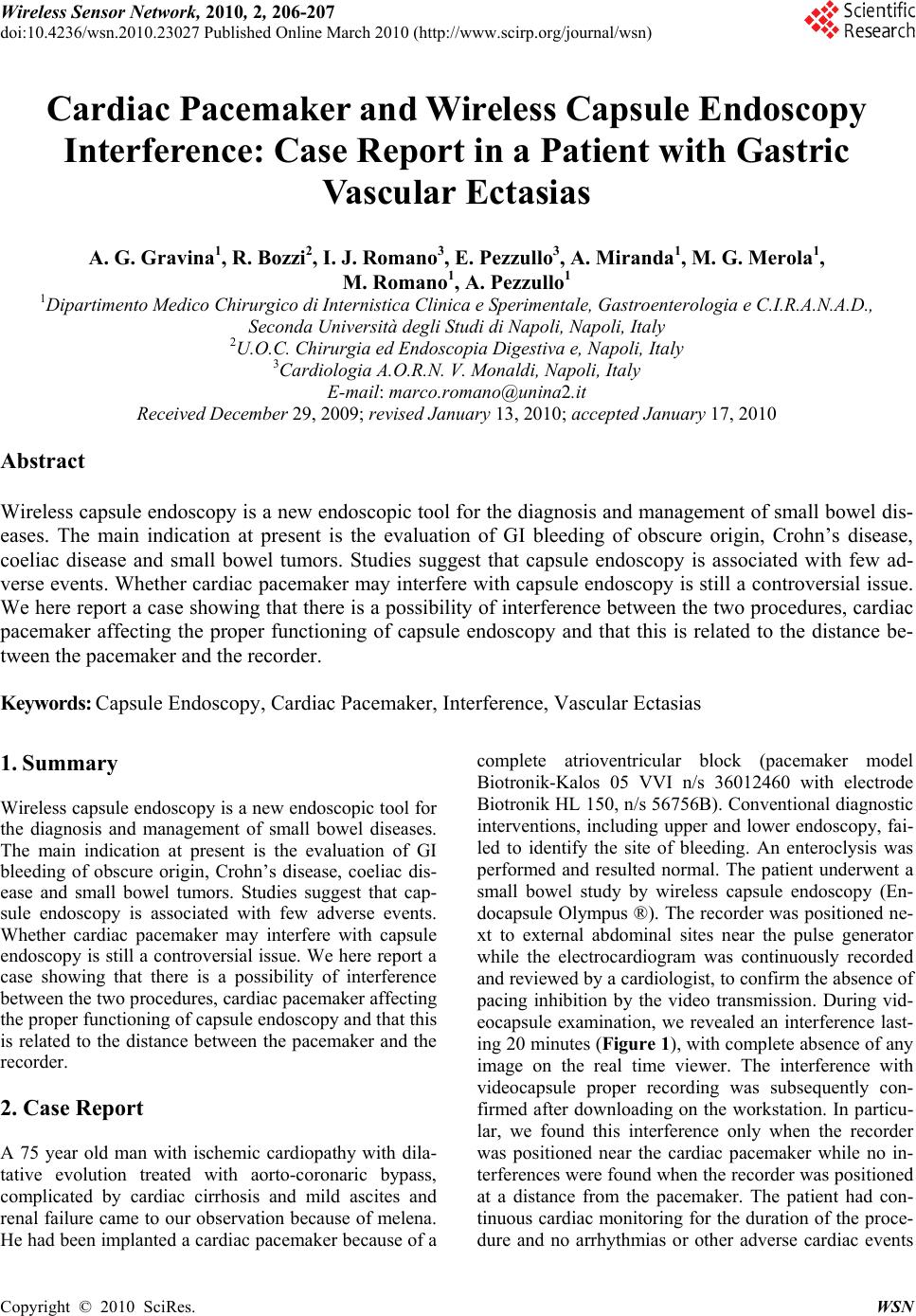Paper Menu >>
Journal Menu >>
 Wireless Sensor Network, 2010, 2, 206-207 doi:10.4236/wsn.2010.23027 Published Online March 2010 (http://www.scirp.org/journal/wsn) Copyright © 2010 SciRes. WSN Cardiac Pacemaker and Wireless Capsule Endoscopy Interference: Case Report in a Patient with Gastric Vascular Ectasias A. G. Gravina1, R. Bozzi2, I. J. Romano3, E. Pezzullo3, A. Miranda1, M. G. Merola1, M. Romano1, A. Pezzullo1 1Dipartimento Medico Chirurgico di Internistica Clinica e Sperimentale, Gastroenterologia e C.I.R.A.N.A.D., Seconda Università degli Studi di Napoli, Napoli, Italy 2U.O.C. Chirurgia ed Endoscopia Digestiva e, Napoli, Italy 3Cardiologia A.O.R.N. V. Monaldi, Napoli, Italy E-mail: marco.romano@unina2.it Received December 29, 2009; revised January 13, 2010; accepted January 17, 2010 Abstract Wireless capsule endoscopy is a new endoscopic tool for the diagnosis and management of small bowel dis- eases. The main indication at present is the evaluation of GI bleeding of obscure origin, Crohn’s disease, coeliac disease and small bowel tumors. Studies suggest that capsule endoscopy is associated with few ad- verse events. Whether cardiac pacemaker may interfere with capsule endoscopy is still a controversial issue. We here report a case showing that there is a possibility of interference between the two procedures, cardiac pacemaker affecting the proper functioning of capsule endoscopy and that this is related to the distance be- tween the pacemaker and the recorder. Keywords: Capsule Endoscopy, Cardiac Pacemaker, Interference, Vascular Ectasias 1. Summary Wireless capsule endoscopy is a new endoscopic tool for the diagnosis and management of small bowel diseases. The main indication at present is the evaluation of GI bleeding of obscure origin, Crohn’s disease, coeliac dis- ease and small bowel tumors. Studies suggest that cap- sule endoscopy is associated with few adverse events. Whether cardiac pacemaker may interfere with capsule endoscopy is still a controversial issue. We here report a case showing that there is a possibility of interference between the two procedures, cardiac pacemaker affecting the proper functioning of capsule endoscopy and that this is related to the distance between the pacemaker and the recorder. 2. Case Report A 75 year old man with ischemic cardiopathy with dila- tative evolution treated with aorto-coronaric bypass, complicated by cardiac cirrhosis and mild ascites and renal failure came to our observation because of melena. He had been implanted a cardiac pacemaker because of a complete atrioventricular block (pacemaker model Biotronik-Kalos 05 VVI n/s 36012460 with electrode Biotronik HL 150, n/s 56756B). Conventional diagnostic interventions, including upper and lower endoscopy, fai- led to identify the site of bleeding. An enteroclysis was performed and resulted normal. The patient underwent a small bowel study by wireless capsule endoscopy (En- docapsule Olympus ®). The recorder was positioned ne- xt to external abdominal sites near the pulse generator while the electrocardiogram was continuously recorded and reviewed by a cardiologist, to confirm the absence of pacing inhibition by the video transmission. During vid- eocapsule examination, we revealed an interference last- ing 20 minutes (Figure 1), with complete absence of any image on the real time viewer. The interference with videocapsule proper recording was subsequently con- firmed after downloading on the workstation. In particu- lar, we found this interference only when the recorder was positioned near the cardiac pacemaker while no in- terferences were found when the recorder was positioned at a distance from the pacemaker. The patient had con- tinuous cardiac monitoring for the duration of the proce- dure and no arrhythmias or other adverse cardiac events  A. G. Gravina ET AL.207 were noted during videocapsule endoscopy. Wireless capsule endoscopy revealed the presence of two vascular lesions in the gastric antrum (Figure 2), suggestive for gastric vascular ectasias. This was confirmed by an EGDS, performed on the same day (Figure 3). 3. Discussions There is a theorical risk of electromagnetic interference between the UHF digital radiofrequency of the wireless videocapsule (433.8 MHz), and mobile phones, im- planted cardiac pacemaker or defibrillator devices. However, interference between wireless capsule endo- scopy and cardiac pacemaker has been observed only in one case [1], but has not been confirmed by others [2–5]. Figure 1. Workstation screen showing significant interfer- ence in the capsule recording. Figure 2. Wireless videocapsule imaging of the stomach showing two gastric lesions suggestive of vascular ectasias. Figure 3. Esophagogastroduodenoscopy showing two vas- cular ectasias in the gastric antrum. In our case, which is the first described using Endocap- sule Olympus ®, we show that cardiac pacemaker may interfere with videocapsule proper functioning leading in our case to a “blank” period of approximately 20 minutes and this depends upon the distance between the recorder and the cardiac pacemaker. In particular no interferences were observed when a distance of about 20 cm between the two devices was maintained. Also, we confirm that wireless capsule endoscopy does not interfere with the correct function of cardiac pacemaker as assessed by continuous cardiac monitoring of the patient. Interest- ingly, wireless capsule endoscopy helped identify the gastric source of the bleeding then confirmed by a sub- sequent EGDS. 4. References [1] Y. Guyomar, L. Vandeville, S. Heuls, et al., “Interference between pacemaker and video capsule endoscopy,” Pac- ing and Clinical Electrophysiology, Vol. 27, pp. 1329– 1330, 2004. [2] J. A. Leighton, V. K. Sharma, K. Srivathsan, et al., “Safety of capsule endoscopy in patients with pacemak- ers,” Gastrointestinal Endoscopy, Vol. 59, pp. 567, 2004. [3] G. Payeras, J. Piquersas, V. J. Morena, et al., “Effects of capsule endoscopy on cardiac pacemakers,” Endoscopy, Vol. 37, pp. 1181–1185, 2005. [4] M. H. Dirks, F. Costea, and E. G. Seidman, “Successful videocapsule endoscopy in patients with an abdominal cardiac pacemaker,” Endoscopy, Vol. 40, pp. 73–75, 2008. [5] D. Bandorski, W. Irnich, M. Bruck, et al., “Capsule en- doscopy and cardiac pacemaker: Investigation for possi- ble interference,” Endoscopy, Vol. 40, pp. 36–39, 2008. Copyright © 2010 SciRes. WSN |

